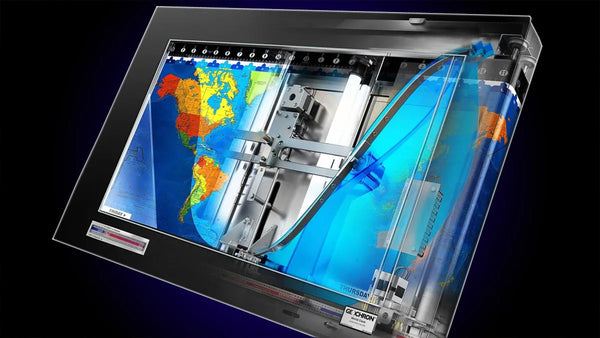- Australia ▾
- Topographic
▾
- Australia AUSTopo 250k (2024)
- Australia 50k Geoscience maps
- Australia 100k Geoscience maps
- Australia 250k Geoscience maps
- Australia 1.1m Geoscience maps
- New Zealand 50k maps
- New Zealand 250k maps
- New South Wales 25k maps
- New South Wales 50k maps
- New South Wales 100k maps
- Queensland 10k maps
- Queensland 25k maps
- Queensland 50k maps
- Queensland 100k maps
- Compasses
- Software
- GPS Systems
- Orienteering
- International ▾
- Wall Maps
▾
- World
- Australia & New Zealand
- Countries, Continents & Regions
- Historical
- Vintage National Geographic
- Australian Capital Territory
- New South Wales
- Northern Territory
- Queensland
- South Australia
- Tasmania
- Victoria
- Western Australia
- Celestial
- Children's
- Mining & Resources
- Wine Maps
- Healthcare
- Postcode Maps
- Electoral Maps
- Nautical ▾
- Flags
▾
- Australian Flag Sets & Banners
- Flag Bunting
- Handwavers
- Australian National Flags
- Aboriginal Flags
- Torres Strait Islander Flags
- International Flags
- Flagpoles & Accessories
- Australian Capital Territory Flags
- New South Wales Flags
- Northern Territory Flags
- Queensland Flags
- South Australia Flags
- Tasmania Flags
- Victoria Flags
- Western Australia Flags
- Gifts ▾
- Globes ▾
Dear valued customer. Please note that our checkout is not supported by old browsers. Please use a recent browser to access all checkout capabilities
A World in the Round: The Glorious, Glossy History of Replogle Globes

Introduction: Spinning the Earth, One Living Room at a Time
Long before the internet let you drop a pin anywhere from Patagonia to Pyongyang, and decades before schoolchildren began mistaking Instagram filters for natural phenomena, the most elegant way to comprehend the Earth was via a globe.
And not just any globe—a Replogle globe.
Standing in foyers and offices, classrooms and dens, Replogle globes have been quietly spinning away since the 1930s. They’ve charted the rise and fall of empires, whispered of tectonic intrigue, and taught generations how to distinguish Sudan from South Australia.
They are not merely teaching tools. They are cultural artefacts. Tactile oaths of curiosity. And this is the story of how a small Chicago business came to put the world—literally—in the hands of millions.
Chapter 1: The Man with the Mission – Luther Replogle and the Basement that Built the World
Our story begins in 1930, in the thick of the Great Depression. A time when optimism was rare, disposable income even rarer, and most Americans wouldn’t have found Albania on a map if you paid them in Model T’s.
Enter Luther Irwin Replogle—a former school supply salesman with a name straight out of Dickens and an unshakeable belief: that every home should have a globe.
Not a dusty, walnut-stained library globe for the professoriate. No, Luther dreamed of something democratic. Accessible. Affordable. Something that could sit proudly on a sideboard in Gary, Indiana, and make its owner feel like a citizen of the world—even if they’d never left the county.
He began, like all great eccentrics, in a basement. His first globes were handmade, using pressed tin spheres covered in painstakingly cut map gores—those strange, banana-peel-shaped panels that are the cartographer’s solution to wrapping a flat map around a ball.
He painted them. He printed them. He sold them door to door.
And slowly, impossibly, they sold.
Replogle had tapped into something deeply aspirational. In an age of financial ruin, his globes offered what America craved: perspective, permanence, and the illusion—however spherical—that the world could still be understood.
Chapter 2: America Buys the World – The Post-War Boom
By the 1940s, Replogle’s humble operation had evolved into a full-scale manufacturing business. Globes were no longer assembled in his basement but produced en masse in a Chicago factory—complete with staff, catalogues, and salesmen in hats.
World War II supercharged the demand. As America emerged as a superpower, so too did its appetite for global awareness. Suddenly, everyone wanted to know where Guadalcanal was. Or Berlin, Seoul, Hiroshima.
Replogle met the moment.
His globes were snapped up by:
-
Schools, looking to visualise shifting frontlines.
-
Military offices, for briefing rooms and strategy.
-
Families, who wanted to follow their sons’ movements with a reverent fingertip across the Pacific.
By 1950, Replogle Globes had become ubiquitous.
But they were also evolving.
Chapter 3: Innovation in Orbit – From Tinplate to Illumination
Luther Replogle was not content to simply mass-produce spheres. He was a man of restless invention.
Over the next two decades, Replogle would pioneer:
-
Illuminated globes: Plug them in, and coastlines glowed like divine revelations. Some even revealed political boundaries under the right bulb.
-
Raised-relief globes: Where you could feel the Himalayas, trace the Andes like Braille, and marvel that the Great Plains were, indeed, so plain.
-
Transparent globes: Where oceans became windows and longitude lines floated like wireframes in a Bond villain’s lair.
-
Globes on casters, globes on bars, globes hiding liquor cabinets, globes with brass meridians so polished they outshone the Equator itself.
It was a golden age for geography, and Replogle stood at its spinning centre.
Other companies tried to compete—Rand McNally, George F. Cram—but none matched Replogle’s combination of accuracy, artistry, and marketing flair. Their motto could have been: Make Earth sexy again.
Chapter 4: Cartographic Time Machines – A Brief History of Everything That Changed
A globe, unlike a map, isn’t merely two-dimensional data. It’s an object—with the power to both date and outdate itself at alarming speed.
This meant Replogle had a unique challenge: the world wouldn’t sit still.
Between 1930 and 1990 alone, the company had to regularly update:
-
The end of the British Empire
-
The division and reunification of Germany
-
The rise and fall of the Soviet Union
-
The birth of Israel, the collapse of Yugoslavia, and the carving up of Africa like a badly sliced cake
Every change required a new set of map gores. Every new globe run, a fresh printing plate.
For cartographic purists, Replogle’s globes are a timeline in three dimensions. A 1961 model? You’ll find the U.S.S.R. in all its crimson majesty. A 1984 globe? Watch the Middle East twist into a different configuration. A post-2001 version? Iraq becomes a regular conversation piece.
Collectors delight in these inconsistencies. One man’s “obsolete” is another man’s Cold War coffee table centrepiece.
Chapter 5: The Moon, the Stars, and a Detour into Space
In 1969, the world turned its eyes skyward. And Replogle, never one to miss a moment, turned its production line moonward.
The result was the Moon Globe—a detailed, crater-filled sphere that mapped the lunar surface using NASA photography. For the first time, schoolchildren could not only see Earth’s neighbour—they could spin it.
Soon followed:
-
Celestial globes, mapping constellations for budding astronomers.
-
Mars globes, albeit less popular with suburban decorators.
The Replogle moon globe became a cult object. Elegant. Scientific. Faintly mysterious.
And in the age of the space race, it said something profound: We’ve not only mapped our world—we’re reaching for others.
Chapter 6: The Digital Revolution – Trouble in the Atlas
Then came the 1990s. The Age of the Internet. A time when people began saying things like “interactive,” “geo-tagged,” and “turn-by-turn navigation,” often without irony.
Globes, once a fixture in every school and study, became novelties. Replogle faced the inevitable question:
Why spin a sphere when you can click a screen?
But the company didn’t fold. It pivoted. It shrank its mass-market production and focused instead on quality and craft.
Globes became premium gifts, collector’s items, and interior design statements.
-
Models like the Franklin offered a scholarly aesthetic with up-to-date cartography.
-
The Diplomat—a 32" floor globe—became a must-have for CEOs who wanted to look casually informed about Botswana.
-
And the Intelliglobe II allowed children to tap the surface with a stylus and hear facts about climate, culture, and how to pronounce “Kyrgyzstan.”
Even in the face of satellite imagery and digital redundancy, Replogle persisted—not because people needed globes, but because they still wanted them.
Chapter 7: Globes as Legacy – The Emotional Cartography of a Family Heirloom
Ask anyone who grew up between 1940 and 1980, and chances are they’ll remember a globe.
It stood in the corner of the classroom, beside the chalkboard and an over-watered fern. Or it sat in the family living room, atop a mahogany cabinet of encyclopaedias nobody quite finished.
Replogle globes are intimate geography. We spun them as children, randomly landing on Kampala or Tashkent, convinced that if the globe had chosen it, we were meant to go.
They’re tied to dreams of travel. Of knowledge. Of a world that was knowable, finite, beautiful.
Even today, to hold a Replogle globe is to be transported—to a more hopeful time, when borders were merely lines and every name had a story.
Chapter 8: Replogle Today – Still Turning
As of the 2020s, Replogle remains the largest globe manufacturer in the world.
Still based in the Chicago area, still printing, still mounting, still resisting the call of the touchscreen.
Their range includes:
-
Decorative globes with antique finishes
-
Interactive globes for education
-
Custom-printed globes for corporate clients and collectors
-
And bespoke artisan models made with brass meridians, hardwood bases, and cartography so crisp you’ll want to frame it
And, yes, you can still buy a basic desk globe for under $100. Because that was Luther’s dream from the beginning—not just to adorn penthouses, but to reach everyone.
Conclusion: The Whole World, in the Palm of Your Imagination
In a world obsessed with the latest, the fastest, the flattest, Replogle globes stand as an elegant contradiction.
They are slow. Tactile. A little romantic. The sort of object that invites not just observation, but contemplation.
And though you can now find the precise location of a noodle shop in Kathmandu via GPS, there is still something sublime in resting your hand on the Indian Ocean and spinning your way north to Siberia.
A Replogle globe doesn’t merely show you the world.
It reminds you you’re part of it.
Postscript: How to Date Your Replogle Globe (Without Offending It)
For the cartographically inclined collector, Replogle globes can be dated using:
-
Country names (e.g., “Zaire” = pre-1997)
-
City names (e.g., “Leningrad” = pre-1991)
-
Cartographic style
-
Mounting hardware
-
Manufacturer stamps (often on the base or equator ring)
A globe is not just a snapshot of the world—but of the moment we thought we understood it.
Leave a comment
Comments will be approved before showing up.
Also in Travel Writings / Product Reviews

Club Med Phuket: Our Full Week in Review
Whether you’re a family chasing a balance between togetherness and independence, a couple craving peace and cocktails, or simply someone ready to trade routine for ritual—this is your place.

Where the Sun Never Sets: A Glorious History of Geochron World Clocks
The Geochron, whether mechanical or digital, offers more than information. It offers perspective. It reasserts the idea that we are part of a rotating story—lit by the sun, divided by clocks, and unified by the gentle ticking of planetary rhythm.

Tracks, Trails & Tassie Tales: A Rambler’s and Rover’s Guide to Tasmania
Tasmania doesn’t just offer adventure. It insists on it. It pulls you into its wilderness, tests your knees and diff locks, and then offers you a view that resets your understanding of beauty.
Christopher O'Keeffe
Author